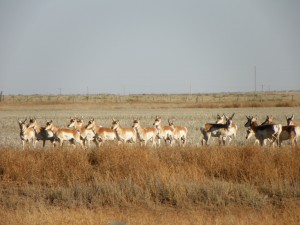
New Mexico landowner, Ray Rush, has reduced soil erosion and increased wildlife habitat on his land throughout his 30-year experience with the Conservation Reserve Program.
“CRP is a wonderful program and I’m very pleased with how it has benefited my farm. Some of the best grassland in the country is right here on my farm.”
That’s from Ray Rush, who operates a farm near Melrose, New Mexico, on the eastern border of the state not far from Amarillo, Texas.
One of the first landowners in New Mexico to sign up for the USDA Farm Service Agency (FSA) Conservation Reserve Program (CRP) in 1986, Rush struggled with erosion problems. He turned to the new conservation program for assistance.
“The land around here can sustain some farming, but I’ve seen plenty of evidence of the scars left behind from those who did not care for it properly,” said Rush.
Rush started his commitment to conservation by enrolling more than 1,500 acres in six CRP contracts. To help protect the soil and promote wildlife habitat, Rush planted or inter-seeded five native species of grasses, along with various legumes and shrubs on those acres.
CRP is among the largest private lands program for conservation used extensively throughout the United States to reduce soil erosion, improve water and air quality and provide wildlife habitat. The program was enacted and signed by President Reagan shortly before Christmas in 1985. When the first CRP enrollment period ended three months later around 750,000 acres had been added and this number grew to nearly 8 million acres by the end of 1986.
The voluntary program allows eligible landowners to receive annual rental payments and cost-share assistance to establish long-term, resource-conserving covers on eligible farmland throughout the duration of their 10-to-15-year contracts.
Almost three years after enrolling in the program, Rush started to see positive results. Land that was nothing but dirt was coming back to life.
“Grass was growing and the antelope were returning,” said Rush.

Three years after enrolling in CRP in 1986, Rush started seeing positive results. The land was coming back to life, drawing antelope and wildlife back to the area.
Today, 1,300 acres of Rush’s farm are enrolled in CRP and he has no intention of taking any of it out now or in the future.
“CRP has made a big difference here in New Mexico,” Rush said. “There is less dirt in the air from wind erosion and fewer acres are being impacted by water erosion during times of heavy rain.”
Landowners like Rush across the state see the benefits of CRP on a daily basis. More than 430,000 acres in New Mexico are currently enrolled in the program.
Since being established on December 23, 1985, CRP has helped prevent more than 8 billion tons of soil from eroding and protected more than 170,000 stream miles with riparian and grass buffers, more than 100,000 acres of bottomland hardwood trees, nearly 300,000 acres of flood-plain wetlands, and 250,000 acres each for duck nesting habitat and upland bird habitat.
2015 marks the 30th Anniversary of CRP. For an interactive tour of CRP success stories from across the U.S., please visit the FSA CRP 30th Anniversary website at http://www.fsa.usda.gov/CRPis30.






One Response to 30-Year Conservation Reserve Program (CRP) Commitment “Made a Big Difference”